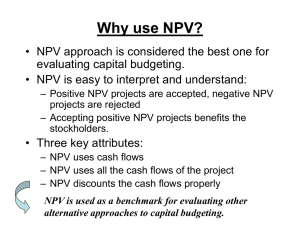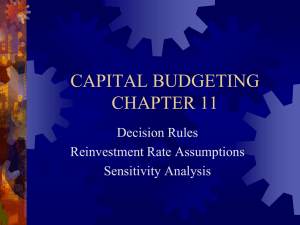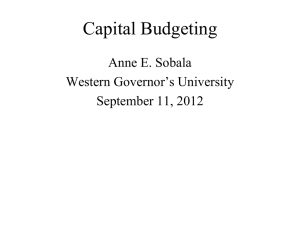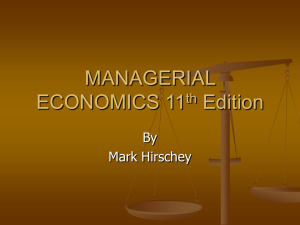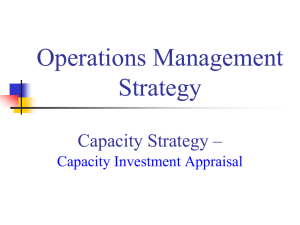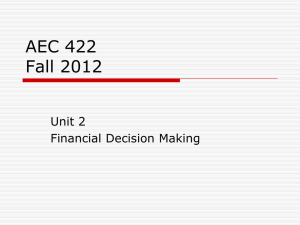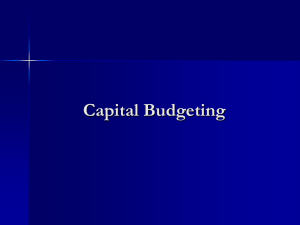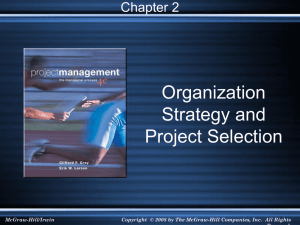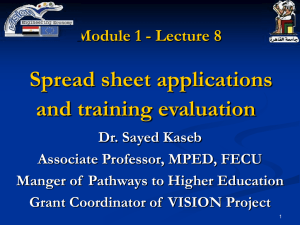Chapter 10 - Dr. Leng Ling
advertisement
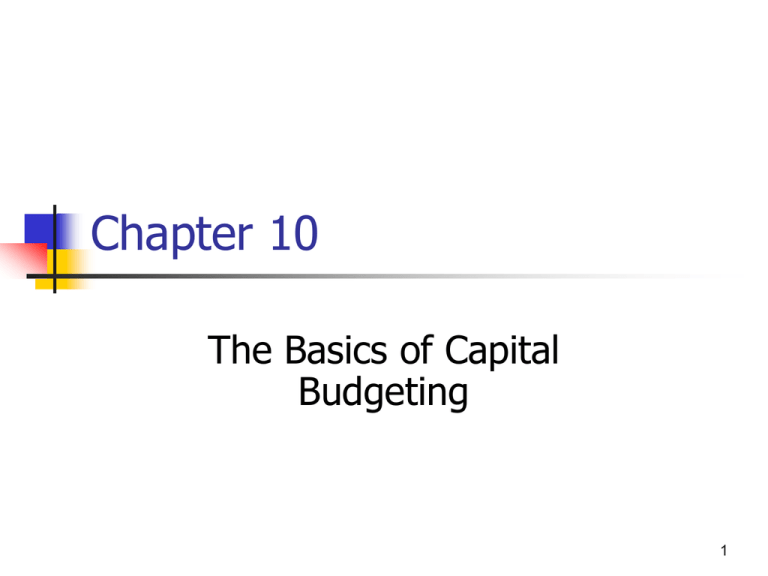
Chapter 10 The Basics of Capital Budgeting 1 Topics Methods NPV IRR, MIRR Payback, discounted payback EAS (EAA) 2 What is capital budgeting? Analysis of potential projects. Long-term decisions; involve large expenditures. 3 Steps in Capital Budgeting Estimate cash flows (inflows & outflows). Determine r = WACC for project. Evaluate 4 Capital Budgeting Project Categories 1. Replacement to continue profitable operations 2. Replacement to reduce costs 3. Expansion of existing products or markets 4. Expansion into new products/markets 5. Contraction decisions 6. Safety and/or environmental projects 7. Mergers 8. Other 5 Independent versus Mutually Exclusive Projects Projects are: independent, if the cash flows of one are unaffected by the acceptance of the other. mutually exclusive, if the cash flows of one can be adversely impacted by the acceptance of the other. 6 Net present value (NPV) rule Accept project if Net present value > 0 What is Net present value? Net present value = Benefits minus Costs 7 How do we measure benefits & costs? N N CIFt COFt NPV = B – C = 1 r t 1 r t t 0 t 0 8 NPV: Sum of the PVs of All Cash Flows N NPV = Σ t=0 CFt (1 + r)t Cost often is CF0 and is negative. N NPV = Σ t=1 CFt (1 + r)t – CF0 9 Cash Flows for Franchises L and S 0 1 2 3 -100.00 10 60 80 0 1 2 3 70 50 20 L’s CFs: S’s CFs: -100.00 10% 10% 10 What’s Franchise L’s NPV? 0 L’s CFs: -100.00 1 2 3 10 60 80 10% 9.09 49.59 60.11 18.79 = NPVL NPVS = $19.98. 11 Calculator Solution: Enter Values in CF Register for L -100 CF0 10 CF1 60 CF2 80 CF3 10 I NPV = 18.78 = NPVL 12 Rationale for the NPV Method NPV = PV inflows – Cost This is net gain in wealth, so accept project if NPV > 0. Choose between mutually exclusive projects on basis of higher positive NPV. Adds most value. 13 Using NPV method, which franchise(s) should be accepted? If Franchises S and L are mutually exclusive, accept S because NPVs > NPVL. If S & L are independent, accept both; NPV > 0. NPV is dependent on cost of capital. 14 Internal Rate of Return: IRR 0 1 2 3 CF0 Cost CF1 CF2 Inflows CF3 IRR is the discount rate that forces PV inflows = cost. This is the same as forcing NPV = 0. 15 NPV: Enter r, Solve for NPV N Σ t=0 CFt = NPV (1 + r)t 16 IRR: Enter NPV = 0, Solve for IRR N Σ t=0 CFt =0 (1 + IRR)t IRR is an estimate of the project’s rate of return, so it is comparable to the YTM on a bond. 17 What’s Franchise L’s IRR? 0 IRR = ? -100.00 PV1 1 2 3 10 60 80 PV2 PV3 0 = NPV Enter CFs, then press IRR: IRRL = 18.13%. IRRS = 23.56%. 18 Rationale for the IRR Method If IRR > WACC, then the project’s rate of return is greater than its cost-- some return is left over to boost stockholders’ returns. Example: WACC = 10%, IRR = 15%. So this project adds extra return to shareholders. 19 Decisions on Franchises S and L per IRR If S and L are independent, accept both: IRRS > r and IRRL > r. If S and L are mutually exclusive, accept S because IRRS > IRRL. IRR is not dependent on the cost of capital used. 20 NPV and IRR: No conflict for independent projects. NPV ($) IRR > r and NPV > 0 Accept. r > IRR and NPV < 0. Reject. IRR r (%) Reinvestment Rate Assumptions NPV assumes reinvest at r (opportunity cost of capital). IRR assumes reinvest at IRR. Reinvest at opportunity cost, r, is more realistic, so NPV method is best. NPV should be used to choose between mutually exclusive projects. 22 Modified Internal Rate of Return (MIRR) MIRR is the discount rate that causes the PV of a project’s terminal value (TV) to equal the PV of costs. TV is found by compounding all inflows at WACC. Thus, MIRR assumes cash inflows are reinvested at WACC. 23 MIRR for Franchise L: First, Find PV and TV (r = 10%) 0 10% -100.0 1 2 3 10.0 60.0 80.0 10% 10% -100.0 PV outflows 66.0 12.1 158.1 TV inflows 24 Second, Find Discount Rate that Equates PV and TV 0 -100.0 1 2 MIRR = 16.5% PV outflows 3 158.1 TV inflows $100 = $158.1 (1+MIRRL)3 MIRRL = 16.5% 25 BAII: Step 1, Find PV of Inflows First, enter cash inflows in CF register: CF0 = 0, CF1 = 10, CF2 = 60, CF3 = 80 Second, enter I = 10. Third, find PV of inflows: Press NPV = 118.78 26 Step 2, Find TV of Inflows Enter PV = -118.78, N = 3, I/YR = 10, PMT = 0. Press FV = 158.10 = FV of inflows. 27 Step 3, Find PV of Outflows For this problem, there is only one outflow, CF0 = -100, so the PV of outflows is -100. For other problems there may be negative cash flows for several years, and you must find the present value for all negative cash flows. 28 Step 4, Find “IRR” of TV of Inflows and PV of Outflows Enter FV = 158.10, PV = -100, PMT = 0, N = 3. Press I/YR = 16.50% = MIRR. 29 Why use MIRR versus IRR? MIRR correctly assumes reinvestment at opportunity cost = WACC. MIRR also avoids the problem of multiple IRRs. Managers like rate of return comparisons, and MIRR is better for this than IRR. 30 Apply NPV, IRR Assume a discount rate of 11%. Compute the NPV, IRR and decide whether the project should be accepted or rejected. Project C0 C1 C2 C3 C4 C5 A T=0 -1000 T=1 400 T=2 400 T=3 400 T=4 500 T=5 500 Verify that NPV = 603.58, IRR = 31.79%, Since NPV>0, IRR>11%, accept the project 31 Conceptual problem: NPV and IRR A. B. C. D. E. Consider a project with an initial outflow at time 0 and positive cash flows in all subsequent years. As the discount rate is decreased the _____________. IRR IRR IRR IRR IRR remains constant while the NPV increases. decreases while the NPV remains constant. increases while the NPV remains constant. remains constant while the NPV decreases. decreases while the NPV decreases. 32 Computational problem: NPV and IRR You are attempting to reconstruct a project analysis of a co-worker who was fired. You have found the following information: The IRR is 12%. The project life is 4 years. The initial cost is $20,000. In years 1, 3 and 4 you will receive cash inflows of $6,000. You know there will be a cash flow in year 2, but the amount is not in the file. The appropriate discount rate is 10%. What is the NPV of the project? 33 Condition 1: Cash inflows occur before cash outflows Thus far, we have considered projects with normal cash flows, (i.e., a single cash outflow in year 0 followed by cash inflows in all future years). With normal cash flows, IRR works fine. However, if you have cash inflow first, followed by cash outflow, then IRR will be negative. Result: You cannot use IRR to make the accept/reject decision. Use NPV to get the correct decision. 34 Condition 2: Cash flows change signs more than once Consider the following project cash flows: t = 0, $400, t = 1, $2,500, t = 2, -$3,000. Suppose that the company’s cost of capital is 70 percent. NPV = $32.53. The project is, acceptable. There are two IRR’s for this project: 61.98%, 363%. Look at the NPV profile (next slide). When there are multiple IRRs, the IRR method loses meaning and is NOT appropriate. However, the NPV method still gives the correct accept/reject decision. 35 What is the payback period? The number of years required to recover a project’s cost, or how long does it take to get the business’s money back? 36 Payback for Franchise L 2.4 3 0 80 50 0 1 2 CFt Cumulative -100 -100 10 -90 60 -30 PaybackL = 2 + $30/$80 = 2.375 years 37 Payback for Franchise S 0 1 1.6 2 3 -100 70 50 20 Cumulative -100 -30 20 40 CFt PaybackS 0 = 1 + $30/$50 = 1.6 years 38 Applying the PBP criterion Compute the payback periods for the following two projects. Project C0 C1 C2 C3 C4 C5 A -9000 2000 3000 4000 5000 6000 B -11000 2000 3000 4000 5000 6000 Verify that PBP for A = 3 years, PBP for B = 3.4 years (assume cash flows occur evenly throughout the year) 39 NPV + PBP Problem Bantam Industries is considering a project which has the following cash flows: Year 0 1 2 3 4 Cash flow ? $2,000 $3,000 $3,000 $1,500 The project has a payback period of 2 years. The firm's cost of capital is 12%. What is the project's net present value? Verify that NPV = 2,265.91 40 Strengths and Weaknesses of Payback Strengths: Provides an indication of a project’s risk. Easy to calculate and understand. Weaknesses: Ignores the TVM. Ignores CFs occurring after the payback period. 41 PBP does not consider cash flows after the critical number A firm uses two years as the critical number for the payback period. This firm is faced with two projects whose cash flows are: Project A B C0 -1000 -1000 C1 500 0 C2 510 0 C3 10 99,000,000 According to the payback rule, project A will be accepted and B will be rejected. But, if you consider all cash flows, including those after 2 years, then project B is more attractive. 42 Discounted Payback: Uses Discounted CFs 0 10% 1 2 3 10 60 80 CFt -100 PVCFt -100 9.09 49.59 60.11 Cumulative -100 -90.91 -41.32 18.79 Discounted = 2 + $41.32/$60.11 = 2.7 yrs payback Recover investment + capital costs in 2.7 yrs. 43 Example of discounted payback period criterion Example: Suppose that the discount rate is 10 percent. Project A has the following cash flows and discounted cash flows. Find A’s discounted PBP. Project A Cash flow Discounted cash flow C0 C1 C2 C3 -9000 3000 6000 9000 2727 4959 6762 Verify that discounted payback period = 2.194 years 44 Normal vs. Nonnormal Cash Flows Normal Cash Flow Project: Cost (negative CF) followed by a series of positive cash inflows. One change of signs. Nonnormal Cash Flow Project: Two or more changes of signs. Most common: Cost (negative CF), then string of positive CFs, then cost to close project. For example, nuclear power plant or strip mine. 45 When There are Nonnormal CFs and More than One IRR, Use MIRR 0 1 2 -800,000 5,000,000 -5,000,000 PV outflows @ 10% = -4,932,231.40. TV inflows @ 10% = 5,500,000.00. MIRR = 5.6% 46 If the two projects have different lifespan, then… 47 S and L are Mutually Exclusive, r = 10% 0 1 2 S: -100 60 60 L: -100 33.5 33.5 3 4 33.5 33.5 Note: CFs shown in $ Thousands 48 NPVL > NPVS, but is L better? CF0 S -100 L -100 CF1 60 33.5 NJ I/YR 2 10 4 10 NPV 4.132 6.190 49 Method 1:mPut Projects on Common Basis Note that Franchise S could be repeated after 2 years to generate additional profits. Use replacement chain to put on common life. 50 Replacement Chain Approach (000s) Franchise S with Replication 0 1 2 3 4 S: -100 60 60 -100 -40 60 60 60 60 -100 60 NPV = $7.547. 51 Method 2:Equivalent annual series (EAS) or Equivalent Annual Annuity (EAA) When projects are mutually exclusive but have unequal lives a. b. We construct the equivalent annual series (EAS) of each project and We choose the project with the highest EAS A project’s EAS is the payment on an annuity whose life is the same as that of the project and whose present value, using the discount rate of the project, is equal to the project’s NPV. 52 Equivalent Annual Annuity Approach (EAA) Convert the PV into a stream of annuity payments with the same PV. S: N=2, I/YR=10, PV=-4.132, FV = 0. Solve for PMT = EAAS = $2.38. L: N=4, I/YR=10, PV=-6.190, FV = 0. Solve for PMT = EAAL = $1.95. S has higher EAA, so it is a better project. 53 Calculating EAS Consider Projects J & K, with the following cash flows. The discount rate is 10%. Project C0 C1 C2 C3 J -12000 6000 6000 6000 K -18000 7000 7000 7000 C4 7000 54 EAS for Project J To compute Project J’s EAS, do the following: Compute Project J’s NPV • Verify that NPV(J) = $2,921.11 Find the payment on the 3-year (life of project J) annuity whose PV is equal to $2,921.11. Enter the following values: N=3, I/Y=10, PV=-2921.11, FV=0, Then CPT, PMT. PMT = 1,174.62, which is Project J’s EAS. So, finding EAS is nothing more than finding the payment of an annuity. 55 EAS for Project K Verify that Project K’s NPV= $4,189.06 Find the payment on the 4-year (life of project K) annuity whose PV is equal to $ 4,189.06. Enter the following values: N=4, I/Y=10, PV=- 4,189.06, FV=0, Then CPT, PMT. PMT = 1,321.53, which is Project K’s EAS. Recall that Project J’s EAS=1174.62 So, choose Project K since it has the higher EAS. 56 Another application of EAA We can use the EAA concept to choose between two machines that do the same job but have different costs and lives. Consider the following problem. 57 Problem Suppose that your firm is trying to decide between two machines, that will do the same job. Machine A costs $90,000, will last for ten years and will require operating costs of $5,000 per year. At the end of ten years it will be scrapped for $10,000. Machine B costs $60,000, will last for seven years and will require operating costs of $6,000 per year. At the end of seven years it will be scrapped for $5,000. Which is a better machine? (discount rate is 10 percent) 58 Step 1: compute the PV of the costs of each machine PV of costs (A) = $90,000 + PV of $5,000 annuity for ten years - PV of the scrap (at t = 10) value of $10,000 = 90000 + 30722.84 – 3855.43 = $116,867.41 PV of costs (B) = $60,000 + PV of $6,000 annuity for seven years - PV of the scrap (at t = 7) value of $5,000 = $60,000 + $29,210.51 - $2,565.79 =$86,644.72 59 Step 2: compute equivalent annual cost (EAC) series of each machine The equivalent annual cost series is the payment of an annuity that has the same present value as the PV of the machine’s cost. EAC of machine A, EAC(A): N = 10, I/Y = 10, PV = -116867.41, FV = 0. Then CPT, PMT. This yields EAC(A) = $19,019.63. EAC of machine B, EAC(B): N = 7, I/Y = 10, PV = -86644.72, FV = 0. Then CPT, PMT. This yields EAC(B) = $17,797.30. Choose machine B because it has the lower cost. 60 Homework Assignment Problems: 1,2,3,4,5,6,7,9,11,13(a,b,c),16,17,21(a, b,c,d) 61
